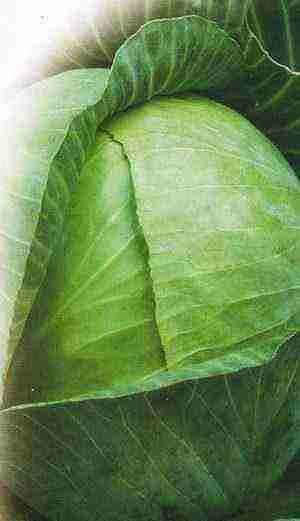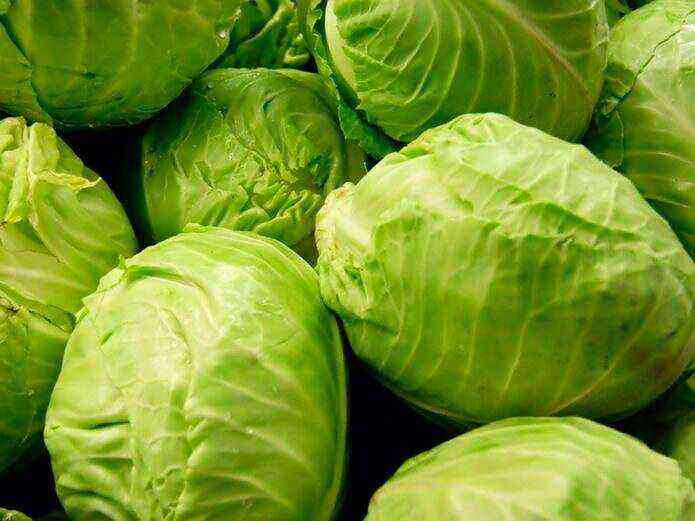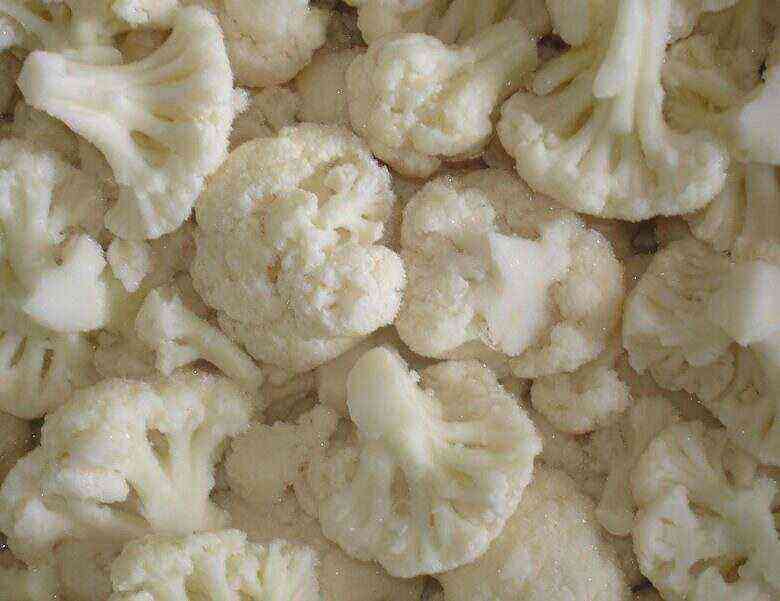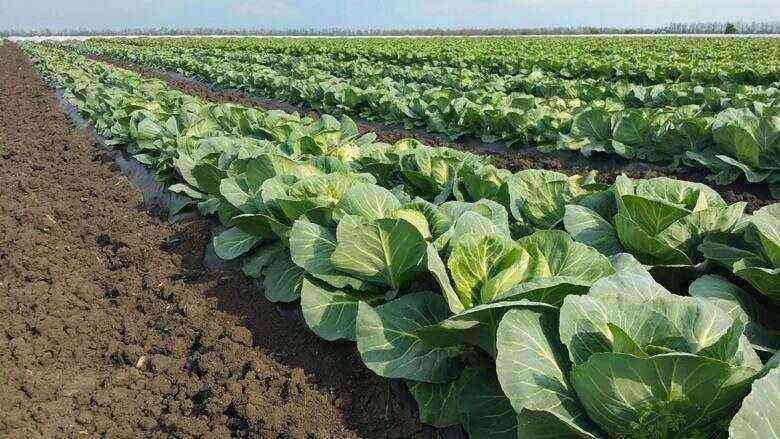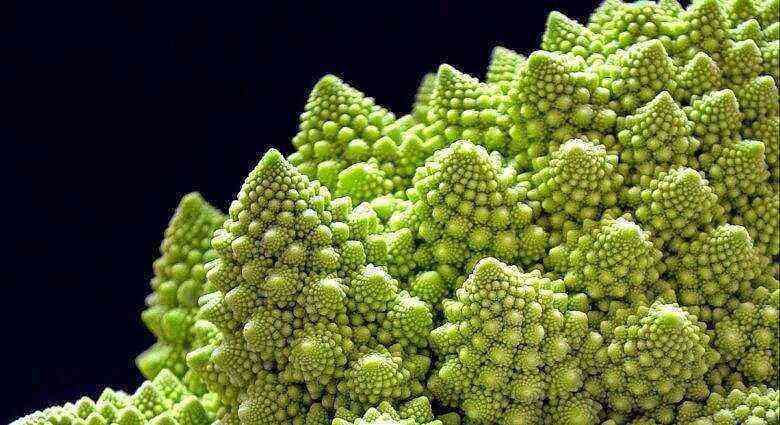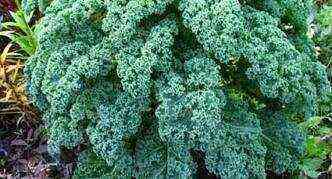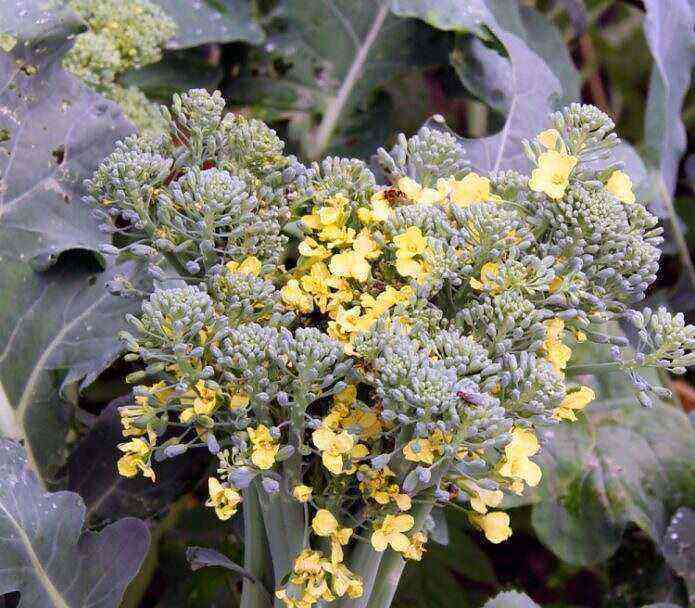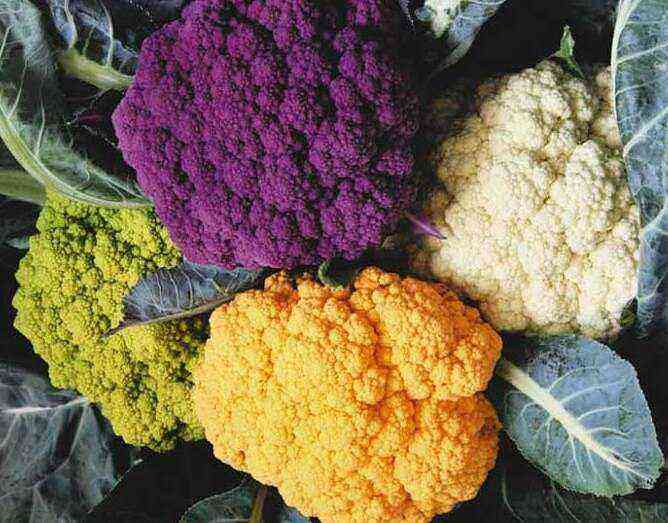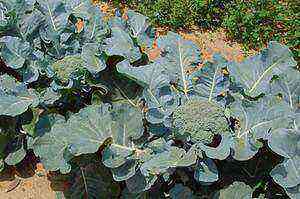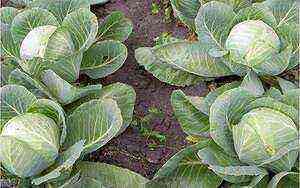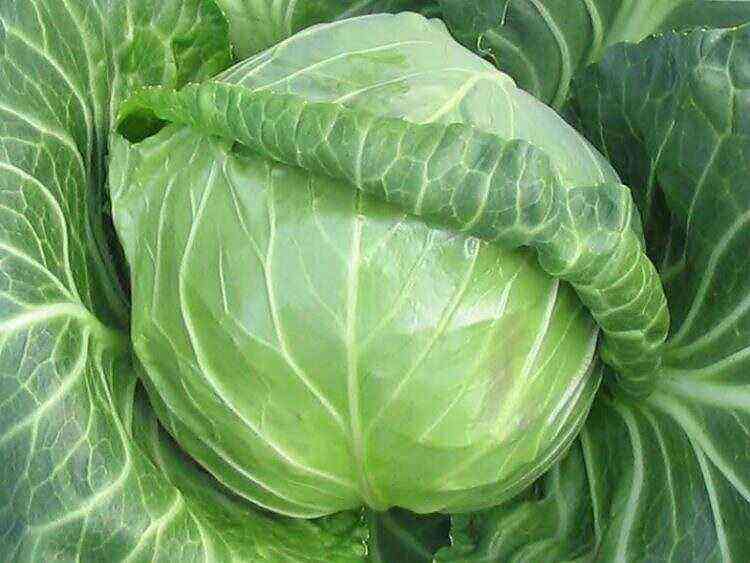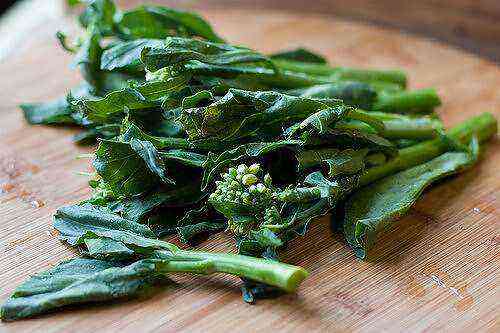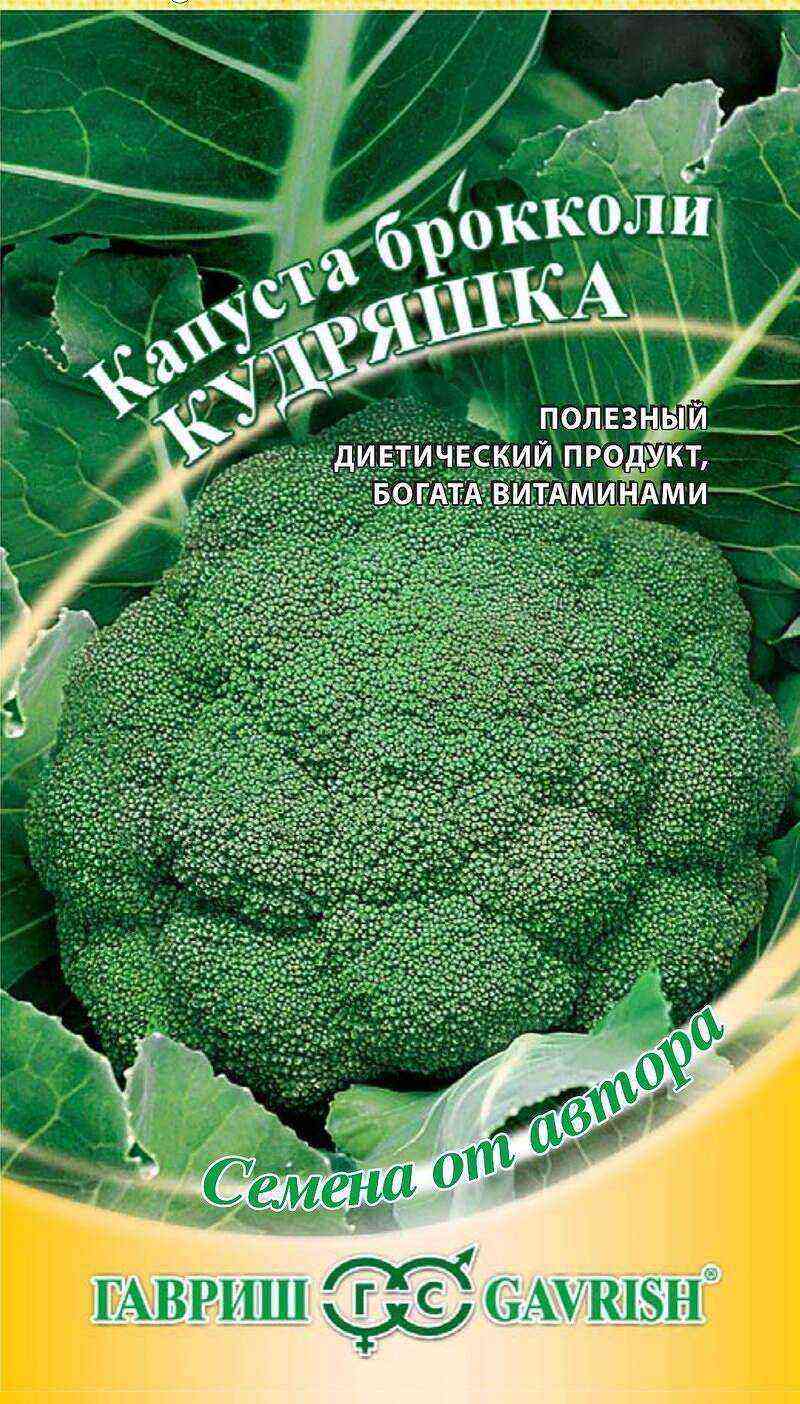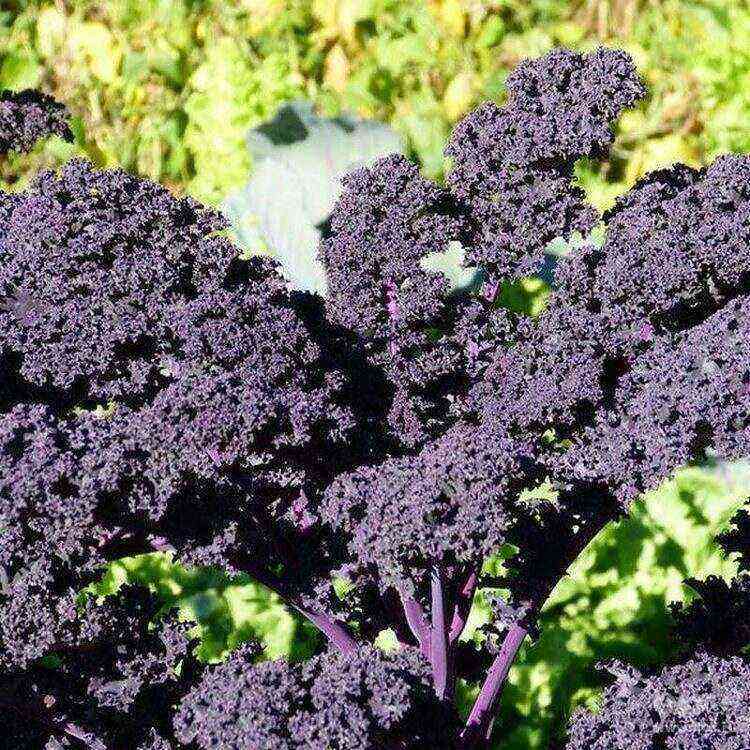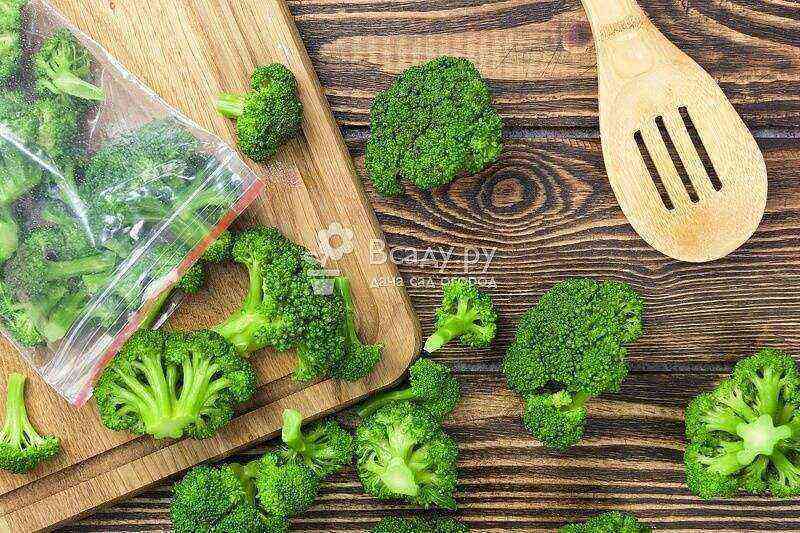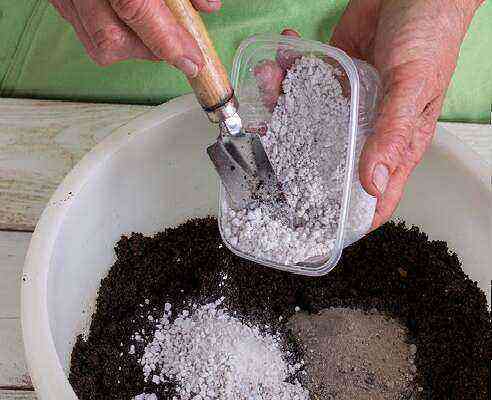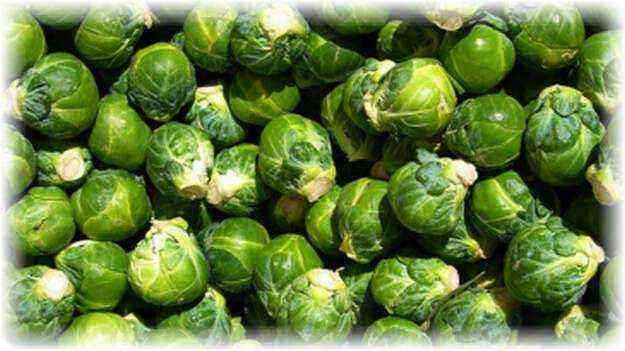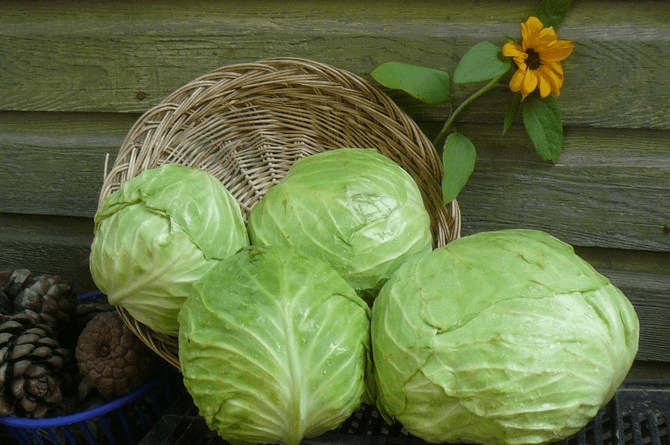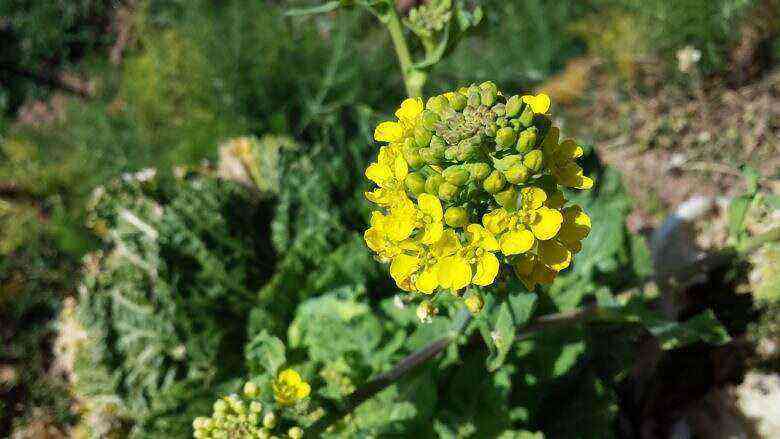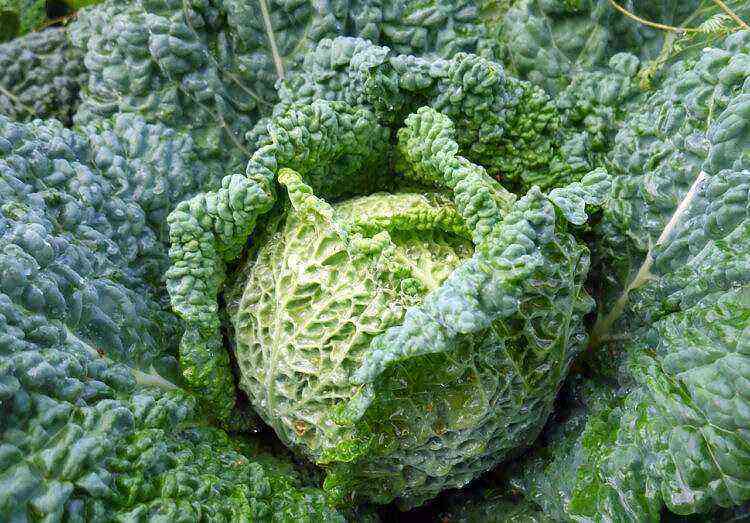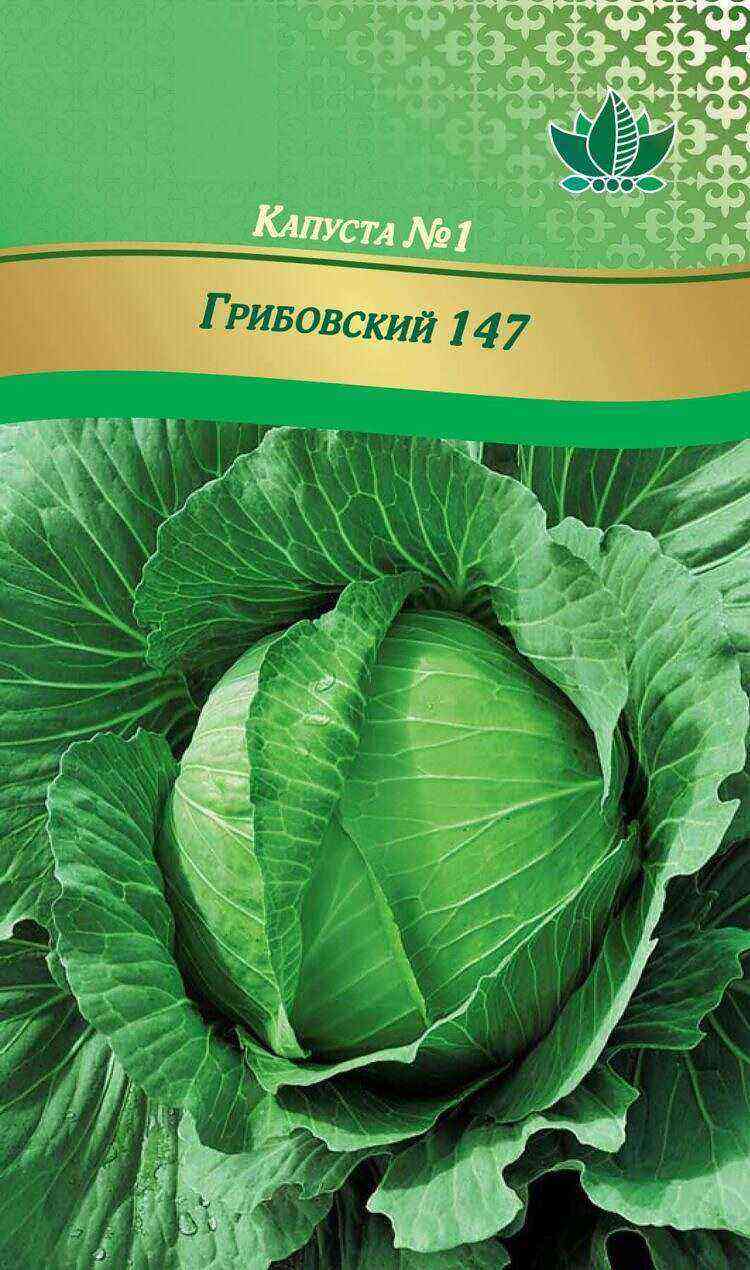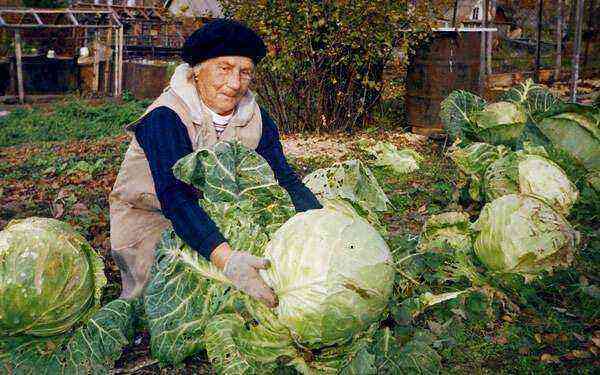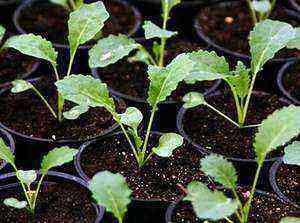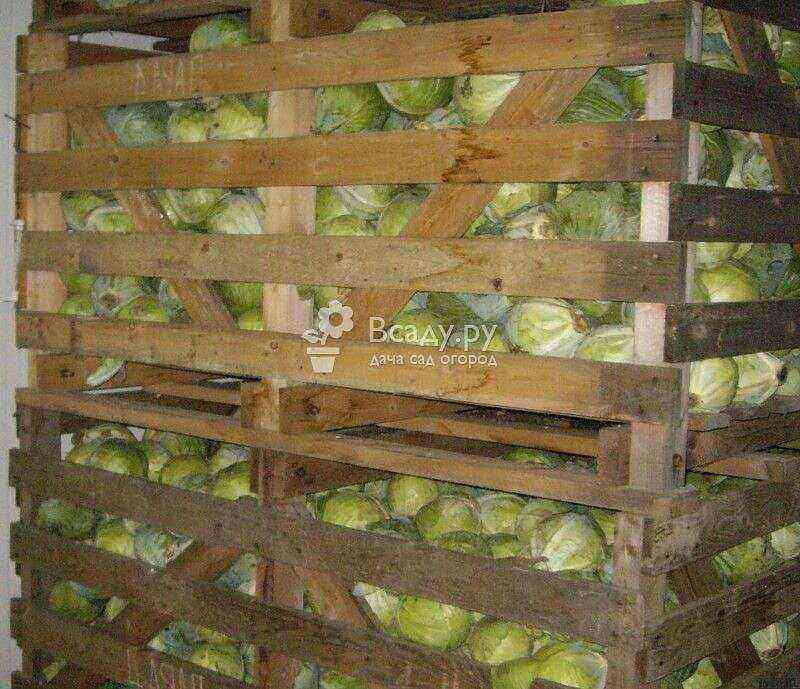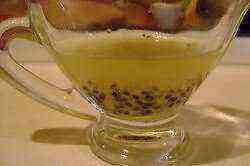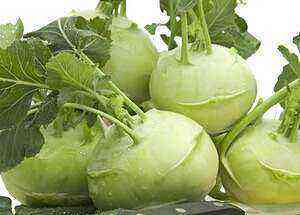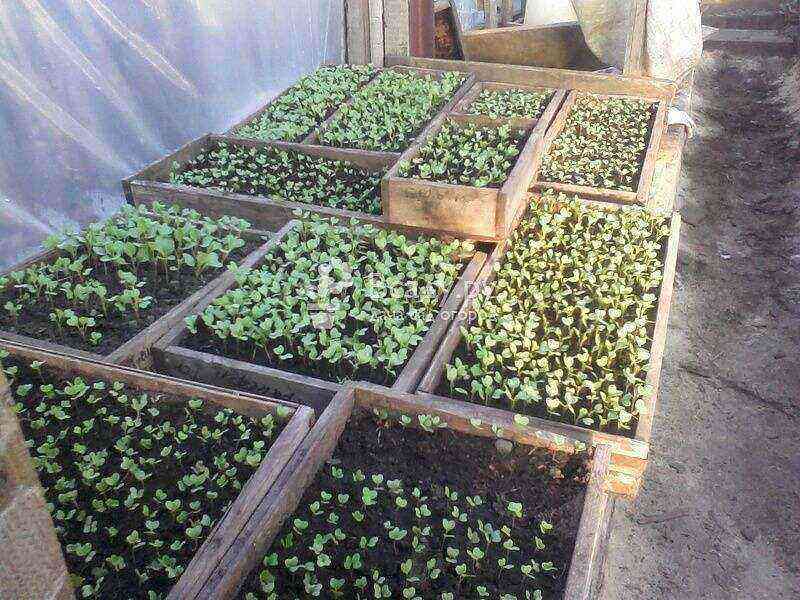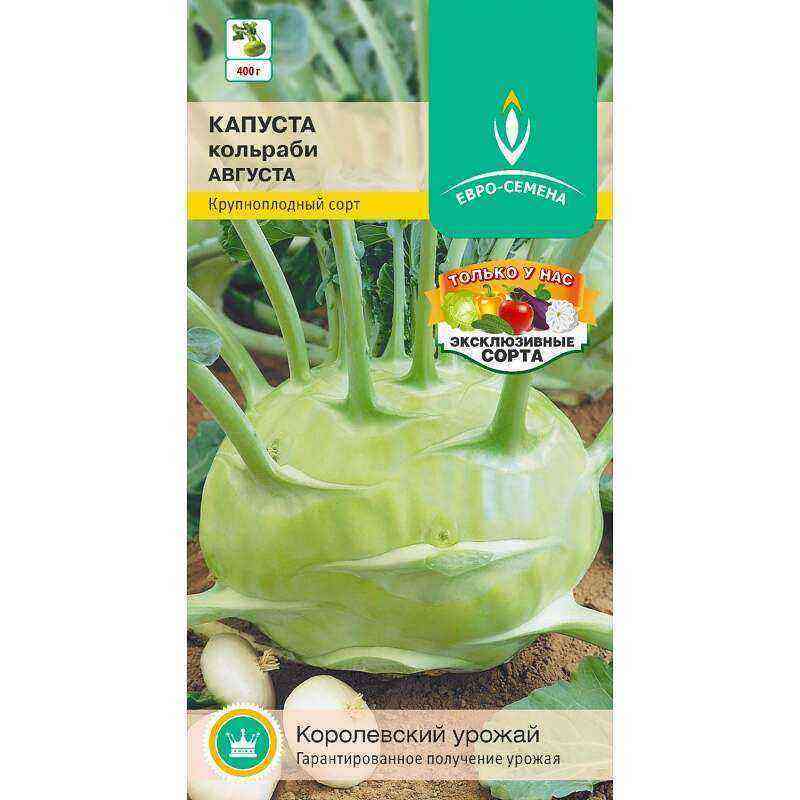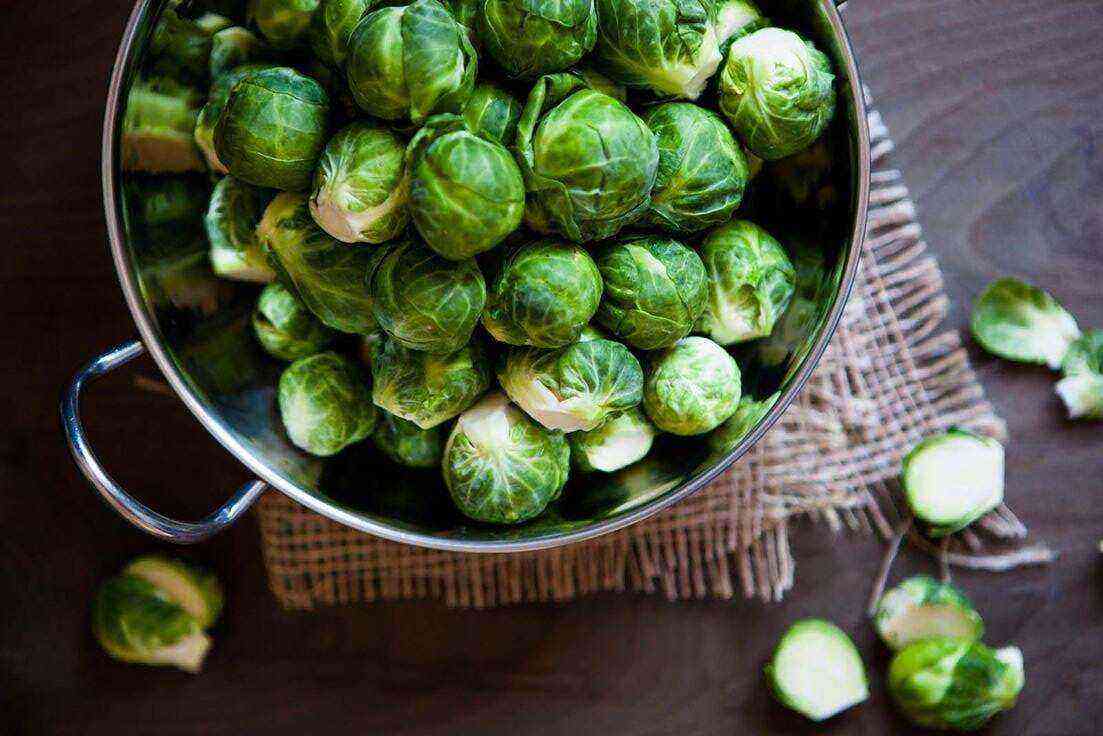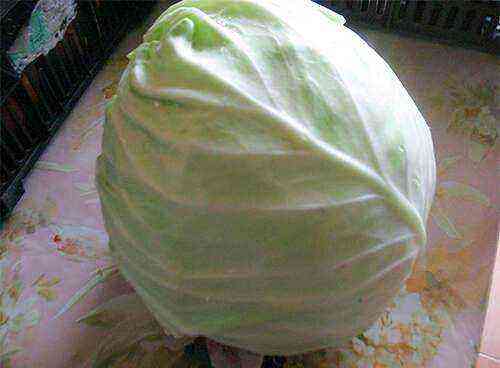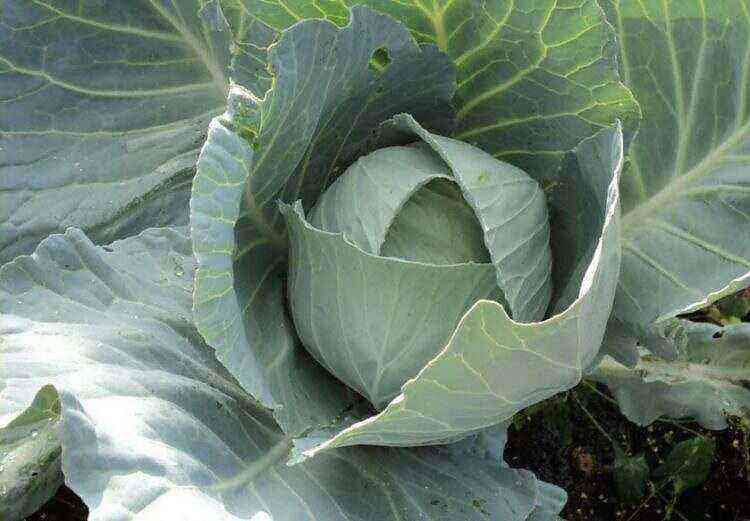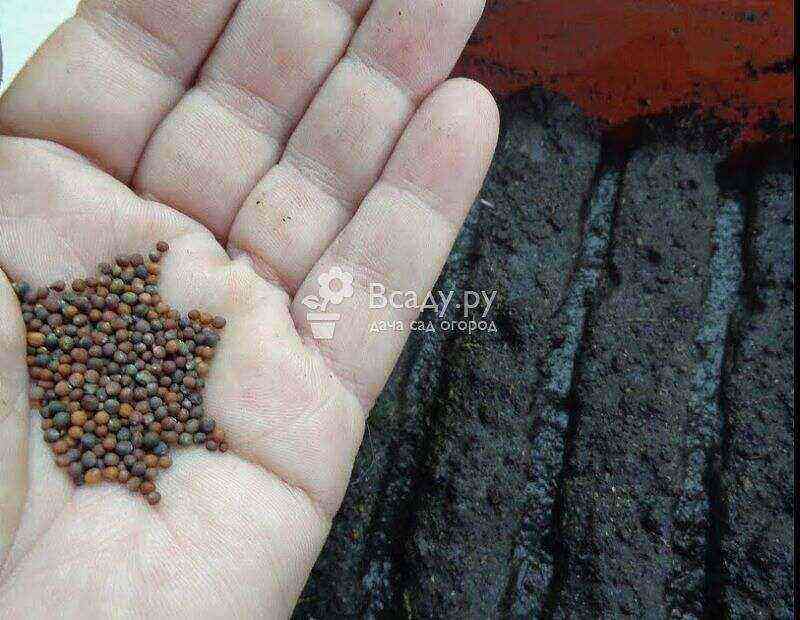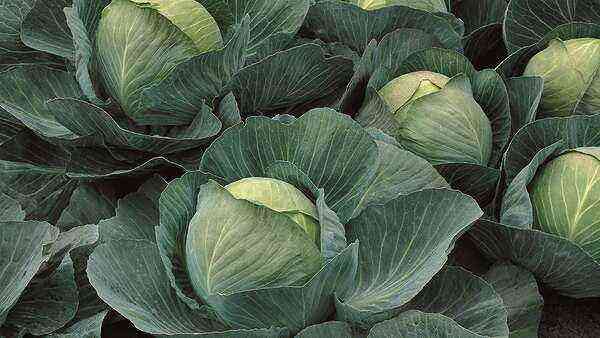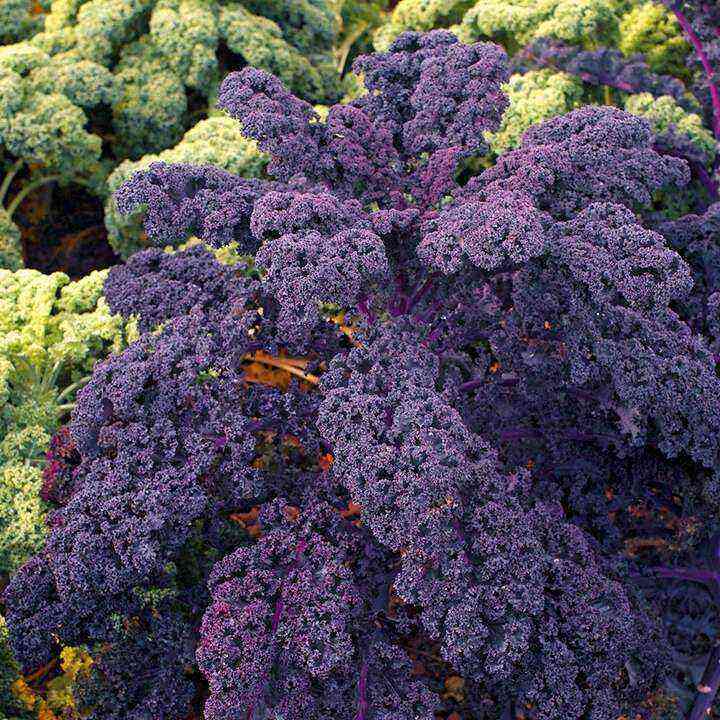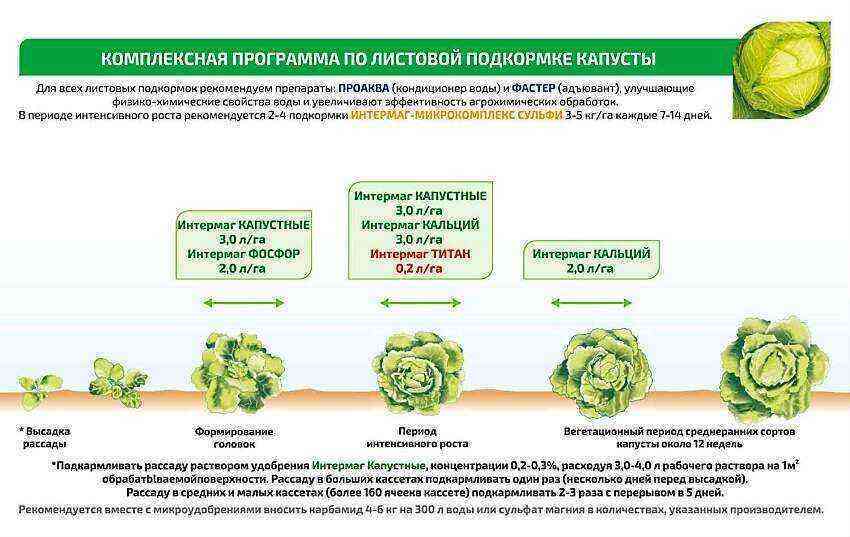Almost all gardeners grow cabbage on their plots. Its early varieties are intended mainly for fresh consumption, while the late ones are great for winter storage. If you create optimal or close conditions for the heads of cabbage, they will easily last until next summer, without losing their taste, density and juiciness. The choice of varieties and hybrids of late maturing cabbage, both Russian and foreign, is extremely wide. To decide, you need to study their advantages and disadvantages in advance.
The best varieties of late cabbage
The growing season for late varieties of cabbage is 140–180 days. The harvest is often harvested after the first frost, but this does not affect the quality of the heads of cabbage. The main advantages of varieties and hybrids of late ripening are high yield, keeping quality, transportability. Heads of cabbage are stored at least until spring, and at most until the next harvest, without losing in the least in presentability, benefits and taste. As a rule, these varieties have good immunity. And what is very important for Russian gardeners, most varieties of late cabbage are great for pickling and pickling.
There are many varieties and hybrids, but not all are popular.
Aggressor F1
Dutch breeding hybrid. The state register of the Russian Federation is recommended for cultivation in the Central region, but practice shows that it brings good harvests in the conditions of the Ural and Siberian climates. Belongs to the category of medium late, from the moment of emergence from seed to harvest, it takes 130–150 days.
Cabbage Aggressor F1 consistently yields a crop, no matter what summer is in terms of weather
The socket is powerful, raised. The leaves are not too large, the central vein is highly developed, because of this, they bend. The surface is finely bubbly, the edge is slightly corrugated. They are painted in a bright green shade with a grayish undertone, characterized by the presence of a layer of gray-silver plaque, reminiscent of wax.
Heads of cabbage are leveled, spherical, average weight – 2,5-3 kg. On the cut, white cabbage. The stump is not particularly large. The taste is not bad, the purpose is universal.
The F1 aggressor is valued by gardeners for the stability of fruiting (cabbage practically does not pay attention to the vagaries of the weather), a low percentage of heads of cabbage rejects (no more than 6–8% of non-marketable species), taste and resistance to fusarium. This is a dangerous disease that can destroy most of the crop both in the garden and during storage. Also, the hybrid successfully resists late blight, the “black leg”. Aphids and cruciferous flea almost do not pamper him with their attention. Cabbage is unpretentious in care, does not make high demands on the quality and fertility of the substrate, the heads of cabbage crack very rarely.
Video: what the cabbage Aggressor F1 looks like
Mara
One of the best achievements of Belarusian breeders. Heads of cabbage are formed in 165-175 days. They are dark green, covered with a thick layer of bluish-gray waxy coating, reaching a weight of 4–4,5 kg. The cabbage is very dense, but juicy. The total yield is 8-10 kg / m². It is an ideal choice for those who ferment their own cabbage.

Mara cabbage is very good sauerkraut
The keeping quality of the Mara variety is very good; under optimal conditions, it is stored until May next year. Another undoubted advantage is the presence of immunity to most types of rot. Heads of cabbage practically do not crack.
Moscow late
There are two varieties of this variety – Moscow late-15 and Moscow late-9. Both were bred quite a long time ago, the first – in the 40s of the last century, the second – 25 years later. There are almost no significant differences, except for the appearance of the outlet. Moscow late-15 has a very high stem, such cabbage is easy to weed, huddle and loosen. In the second variety, the rosette, on the contrary, is low, squat, it seems that the head of cabbage is lying directly on the ground. It is more difficult to look after her, but she is not amazed by the keel.
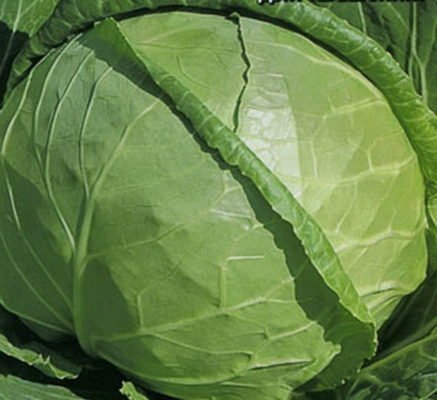
Cabbage Moscow late-15 is easy to care for – the heads of cabbage seem to stand on high legs
These cabbage varieties are recommended by the State Register for cultivation in the Far East, North-West, in the Central region. They are stored until the middle of next summer. They tolerate cold temperatures down to -8–10 ° C without much damage to themselves.

Cabbage Moscow late-9 is not affected by the keel
The leaves are large, broadly oval, wrinkled, with slightly corrugated edges. There is almost no wax coating. The heads of cabbage are slightly flattened, dense, yellowish on the cut, weighing on average 3,3–4,5 kg. But there are also “champions” weighing 8-10 kg. The marriage rate is very low – 3-10%.
Video: Moscow late cabbage variety
Amager 611
A fairly old medium-late variety of Soviet selection, it was included in the State Register back in 1943. There are no restrictions on the growing region. The ripening period of the crop is highly dependent on the weather, the growing season is 117-148 days.
The diameter of a rather powerful rosette is 70–80 cm. The leaves are slightly raised, they can be almost round, and a very interesting shape, somewhat reminiscent of a lyre. The surface is almost smooth, even mild wrinkles are rare. The edge is also smooth. The leaves are covered with a thick layer of bluish bloom. The stem is rather high, 14-28 cm.
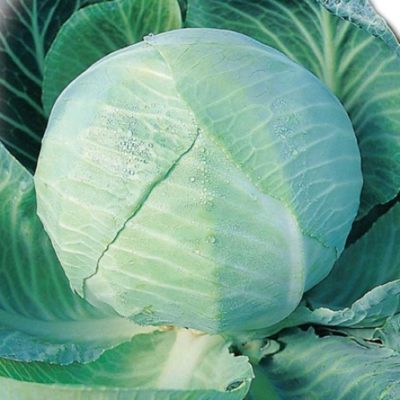
The taste qualities of Amager 611 cabbage cannot be called outstanding, its leaves are dryish and rough
The average weight of a flattened head of cabbage is 2,6–3,6 kg. They practically do not crack. The taste cannot be called outstanding, and the leaves are rather coarse, but this cabbage is very good in salted and sauerkraut. Practice shows that during storage (Amager 611 can last until the middle of next spring) the taste improves. But this cabbage must definitely create optimal conditions, otherwise the development of gray rot, necrosis is very likely.
Snow White
It was bred back in the USSR, but now it is popular with gardeners. The growing season is 130–150 days. Differs in general unpretentiousness in care, is not affected by fusarium, during storage does not suffer from mucous bacteriosis. The only thing that she categorically does not tolerate is an acidic substrate.
The average weight of a pale green head of cabbage is 2,5–4,2 kg. The shape is almost round or slightly flattened. They are very dense but juicy. Fruiting is amicable, heads of cabbage rarely crack. This cabbage is notable for its transportability, it can be stored for at least 6–8 months, but provided that a constant temperature of at least 8 ° C is ensured.
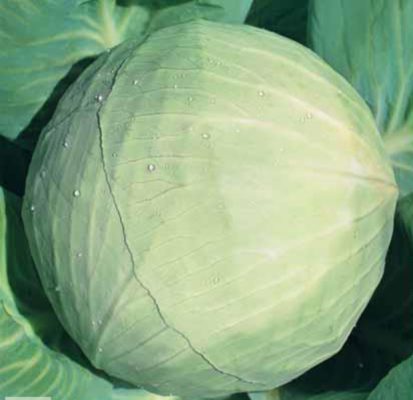
Snow White cabbage is not only delicious but also extremely healthy.
Snow White is valued mainly for its wonderful taste and high content of vitamins, micro- and macroelements. Moreover, the benefits are not lost when fermenting and salting. This cabbage is recommended to be included in the diet of children and the elderly.
Megaton F1
Another hybrid from the Netherlands that is often found on the personal plots of Russians. Among the late ones, it ripens one of the first. The growing season is 136–78 days.
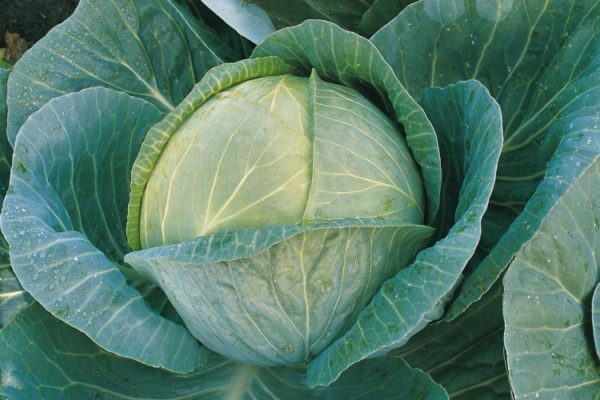
Cabbage Megaton F1 – one of the most popular Dutch hybrids in Russia
The outlet is spreading, powerful, squat. The leaves are large, pale green, almost round, concave due to the highly developed central vein, corrugated along the edge. There is a layer of wax coating, but not too noticeable.
The head of cabbage is also pale green, very dense, the stump is short. Average weight – 3,2-4,1 kg. The taste is wonderful, the yield is consistently high. The variety has immunity to fusarium, rather rarely it is affected by keel and gray rot. Insects do not pay much attention to this cabbage either.
Video: what Megaton F1 cabbage looks like
Gingerbread Man
Russian variety, bred in the mid-90s of the last century. There are no restrictions on the region of cultivation. The growing season is 145–150 days.
The rosette is raised, the stem height is 30–34 cm, very compact (45–55 cm in diameter). Leaves are broadly oval, deep green. The surface is smooth, along the edge there is a light wave. A layer of gray-gray waxy coating is thick, clearly visible.
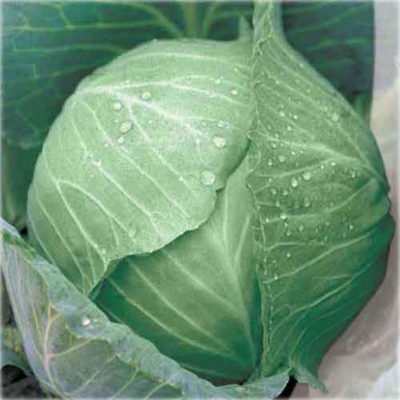
Fresh cabbage Kolobok is not very tasty, but during storage the situation is corrected
The head of cabbage is almost round, pale green on the cut. Average weight is about 5 kg. The taste is excellent. This cabbage cracks very rarely. The Kolobok is stored until May next year. It has immunity to the most dangerous diseases for culture – fusarium, mucous and vascular bacteriosis, all types of rot. Fresh cabbage is almost never eaten – immediately after cutting it has a bitter taste that disappears during storage.
Wintering 1474
Soviet variety specially created for storage. Even in far from optimal conditions, this cabbage will last at least until mid-winter. If it is stored correctly, in January-February they just start eating it. During this time, the palatability improves significantly, the heads of cabbage seem to gain juiciness. The state register is recommended for cultivation in the Volga region and the Far East.
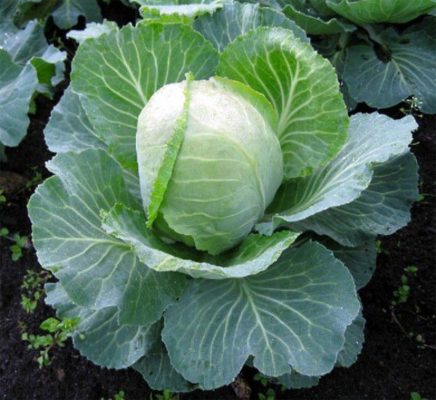
Cabbage variety Zimovka 1474 was bred specifically for long-term storage
The socket is not particularly powerful, slightly raised. The leaves are ovate, large, painted in a grayish-green color, covered with a thick layer of waxy bloom. The surface of the lamina is moderately wrinkled, the edges are noticeably corrugated.
The average weight of a head of cabbage is 2-3,6 kg. They are slightly flattened, with a rather long stump. The percentage of non-commercial products is no more than 2–8%. Cabbage does not crack, and does not suffer from necrosis during storage.
Languedoc
An old variety, proven by more than one generation of gardeners, bred in Holland. The growing season is 150-165 days. It is appreciated for its excellent taste, which only improves during storage, resistance to most common cabbage diseases (especially bacteriosis), keeping quality and ability to tolerate transportation well. The purpose is universal. This cabbage is good both fresh and homemade.
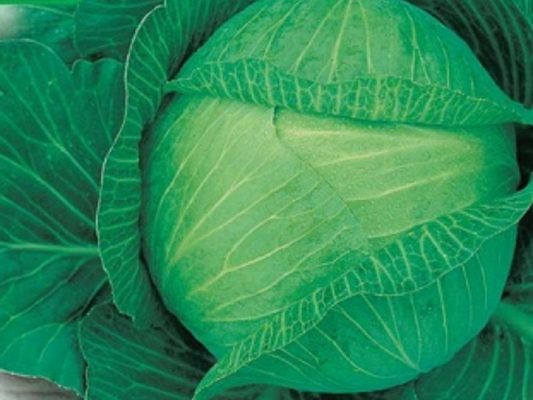
Languedaker is a variety of cabbage grown not only at home, but all over the world
Dark green dense broad-oval heads of cabbage do not crack. This also applies to those that are fully ripe, but not yet harvested. The average weight of cabbage is 3,5–5 kg. 1-9 kg are removed from 10 m². Langedeiker tolerates prolonged drought and heat well, is able to “forgive” the gardener for improper watering.
Turquoise
German variety from the late category. The crop is harvested 165–175 days after mass germination. Heads of cabbage are stored for at least 6-8 months, do not crack in the process, extremely rarely become infected with pathogenic fungi. Plants also rarely get sick in the open field, demonstrating the presence of “innate” immunity to phomosis, carinae, fusarium wilt and all types of bacteriosis. In comparison with other varieties, the variety is drought-resistant.

Turkiz cabbage is valued for its good drought resistance
Heads of cabbage are medium in size (2-3 kg), regular round shape, dark green. The total yield is 8-10 kg / m². The taste is very good, sweetish, the cabbage is juicy. Sauerkraut is very good.
Kharkov winter
The variety, as it is easy to understand, comes from Ukraine. I got into the State Register in 1976. The purpose of cabbage is universal – it is good fresh, in homemade preparations, it is also suitable for storage (it will last up to 6-8 months). Ripens in 160-180 days.

Kharkiv winter cabbage during storage does not become infected with bacteriosis
The rosette is slightly raised, spreading (diameter 80–100 cm), the leaves are elliptical, almost smooth, only a light wave goes along the edge. A thick layer of waxy coating is characteristic. Heads of cabbage are flattened, weighing 3,5–4,2 kg. The taste is excellent, the defect rate is low (no more than 9%).
The variety tolerates both low and high temperatures (from -1–2 ° C to 35–40 ° C) and is distinguished by drought resistance. During storage, heads of cabbage are not infected with necrosis and mucous bacteriosis. 1-10 kg are obtained from 11 m². Ripe cabbage can be cut off until the first frost – it will not crack or deteriorate.
Mom F1
A hybrid, which the State Register advises to cultivate in the Volga region. Heads of cabbage are not particularly dense, but keep well for up to six months. The growing season is 150–160 days.
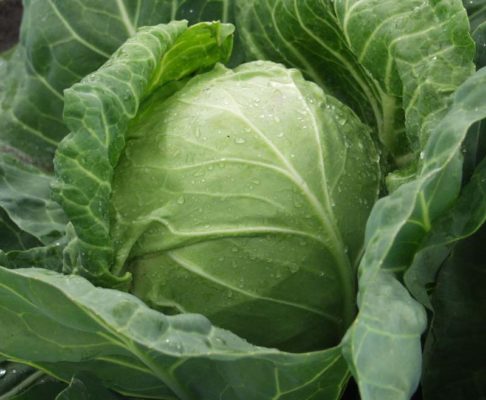
Cabbage Mama F1 does not differ in the density of heads of cabbage, but this does not affect keeping quality
The socket is slightly raised. The leaves are medium-sized, grayish-green, covered with a light layer of waxy bloom. The surface is almost smooth, slightly bubbly, the edges are even. Heads of cabbage are slightly flattened, pale green on the cut, leveled (average weight 2,5–2,7 kg). The marriage rate is low – up to 9%.
Valentina F1
The hybrid was bred relatively recently, quickly won the love of Russian gardeners. The growing season is 140–180 days. Resistant to fusarium wilt. There are few heads of non-marketable type, no more than 10%. Shelf life is 7 months or more.

Valentina F1 cabbage is a relatively recent achievement of breeders, but gardeners quickly appreciated it.
The rosette is quite powerful, but the leaves are medium-sized, of a grayish-green hue. The surface is almost smooth, covered with a thick layer of gray waxy coating.
Heads of cabbage are medium in size, weighing 3,2-3,8 kg, ovoid, white-green on cut. It is characterized by a very high density and a small stump. The taste is simply wonderful, the cabbage is crispy and sugary. An excellent choice for fermentation.
Sugar Loaf
The variety is recommended by the State Register for cultivation in Western Siberia, it is distinguished by its versatility of purpose. Shelf life is at least 8 months. The growing season is 160–165 days.
The socket is raised, powerful. The leaves are large, dark green with a grayish tint, the wax coating is not too noticeable. The surface is almost even, only slight “bubbling” and corrugation along the edge are characteristic.

Sugarloaf cabbage does not even have a slight bitterness
Heads of cabbage are spherical, white-green on the cut. The stump is very short. Average weight – 2,2-2,8 kg. They do not differ in special density, but this does not affect keeping quality. The percentage of marketable products is 93%. The variety is appreciated not only for its excellent taste and complete absence of bitterness. Among its undoubted advantages is resistance to keel, fusarium wilt and bacteriosis.
Orion F1
The state register recommends growing this hybrid in the North Caucasus. It takes 165-170 days for the heads of cabbage to ripen.
The rosette is vertical, low (35–40 cm), rather compact (68–70 cm in diameter). The leaves are almost round, with very short petioles. The stem is 18–20 cm high. The heads of cabbage are elongated, very dense, weighing about 2,3 kg. On the cut, the cabbage is creamy white. Good taste, as well as keeping quality. Until May next year, 78–80% of heads of cabbage are preserved.
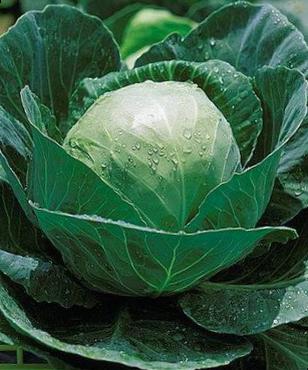
Orion F1 cabbage – these are medium-sized, but very dense heads of cabbage
The hybrid successfully resists bacteriosis, somewhat worse – fusarium. The crop yields consistently, no matter how lucky the gardener is with the summer weather. Heads of cabbage practically do not crack, ripen together.
Lennox F1
A hybrid originally from Holland. Restrictions regarding the region of cultivation are not established by the State Register. Cabbage is good both fresh and after long-term storage. Heads of cabbage ripen in 167-174 days. Shelf life – up to 8 months. This cabbage, thanks to its powerful root system, tolerates drought well.
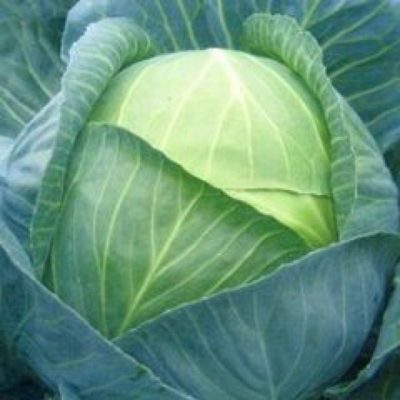
Cabbage Lennox F1 stands out for its good drought resistance
The socket is quite compact. The leaves are large, ovoid, grayish-green with a lilac tint, concave along the central vein. The surface is finely wrinkled, the edges are even. The presence of a thick waxy coating is characteristic. Heads of cabbage are spherical, weighing 1,6–2,4 kg, very dense. The total yield is 9-10 kg / m². The hybrid is valued for its sugar content, it has a high content of vitamin C.
Video: an overview of popular varieties of late cabbage
Recommendations for growing a crop
Caring for late cabbage is not much different from growing other varieties. The main nuances are related to the length of the growing season. Heads of cabbage take longer to ripen and require more nutrients.
Planting procedure and preparation for it
Since it takes about five to six months from the moment the seedlings emerge to the maturation of the heads of cabbage for most varieties of late-ripening cabbage, in a temperate climate it is grown exclusively by seedlings. Seeds in Russia can be planted directly into the ground only in southern regions with a subtropical climate.
Modern varieties and hybrids have good immunity, but in general, cabbage is prone to damage by pathogenic fungi. To avoid this, the seeds undergo special training before planting. For disinfection, they are immersed in hot (45–50 ° C) water for a quarter of an hour, then in cold water for just a couple of minutes. Another option is etching in a fungicide of biological origin (Alirin-B, Maxim, Planriz, Ridomil-Gold) or in a bright pink solution of potassium permanganate. To increase germination, use any biostimulants (potassium humate, Epin, Emistim-M, Zircon). The solution is prepared according to the manufacturer’s instructions, the seeds are immersed in it for 10-12 hours.
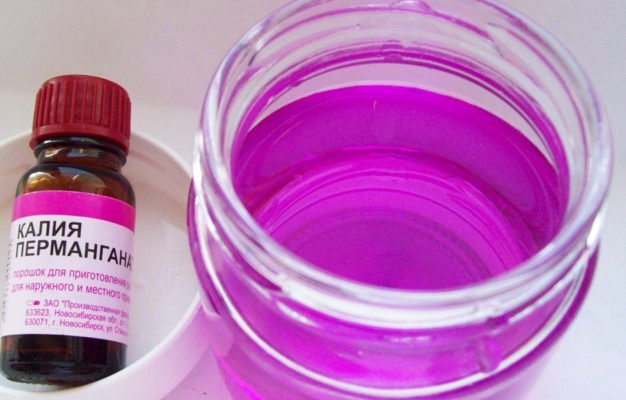
A solution of potassium permanganate is one of the most common disinfectants, soaking cabbage seeds in it is an effective prevention of fungal diseases
The optimal time for planting late cabbage for seedlings is late March or early April. The seedlings are transferred to the ground in the first half of May, the harvest is harvested in October. In the southern regions, all these dates are postponed 12-15 days ago. These varieties and hybrids are not afraid of autumn frosts, negative temperatures do not affect keeping quality.
Any cabbage tolerates transplanting and picking very badly. Therefore, they immediately plant it in small peat pots. Soil is a mixture of humus, fertile soil and sand in approximately equal proportions. For the prevention of fungal diseases, add a little crushed chalk or wood ash. Before planting, the substrate is well moistened. The seeds are buried 1–2 cm, sprinkled on top with a thin layer of fine sand.
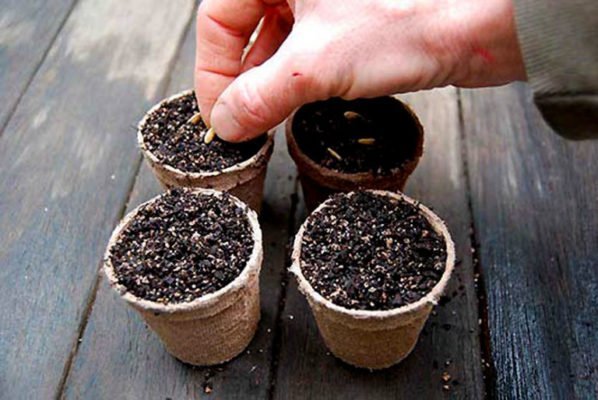
Cabbage planted in peat pots can be transferred to the garden without removing it from the container
Until emergence, containers are kept in a dark, warm place under a film or glass. As a rule, seeds germinate in 7-10 days. Seedlings need to be provided with 10-12 hours of daylight. The temperature in the first 5–7 days is lowered to 12–14 ° C, then raised to 16–18 ° C. The substrate is constantly maintained in a moderately moist state, but not poured (this is fraught with the development of a “black leg”).

For proper development, cabbage seedlings require a sufficiently low temperature.
In the phase of the second true leaf, cabbage is fed with mineral nitrogen fertilizers (2-3 g per liter of water). A week later, it is watered with a solution of a complex seedling agent (Rostock, Solution, Kristalin, Kemira-Lux). About a week before transplanting, cabbage begins to harden, making it easier for it to adapt to new conditions. Seedlings ready for planting reach a height of 17–20 cm and have 4–6 true leaves.

Do not hesitate to plant cabbage seedlings in the ground: the older the plant, the worse it takes root in a new place
Video: growing cabbage seedlings
The garden bed is prepared in advance, choosing an open place. Even a light partial shade is not suitable for the culture. Due to the high humidity of the air and soil, any lowlands are excluded. Do not forget about crop rotation. Cabbage grows best after beets, herbs, legumes and nightshades. Cruciferous relatives are undesirable as predecessors.
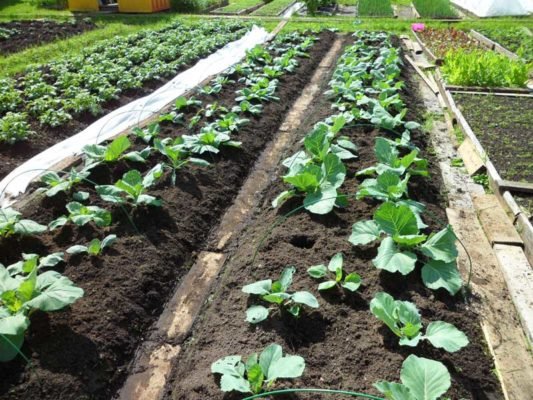
For growing cabbage, choose an open place well warmed by the sun.
Cabbage needs light, but nutritious soil. She categorically does not tolerate sour and salty substrate. When digging into the soil, humus or rotted compost, dolomite flour, phosphorus and potash fertilizers are necessarily introduced into the soil (can be replaced with sifted wood ash). In the spring, 10-15 days before planting, the bed is loosened well and mineral nitrogen fertilizers are added.
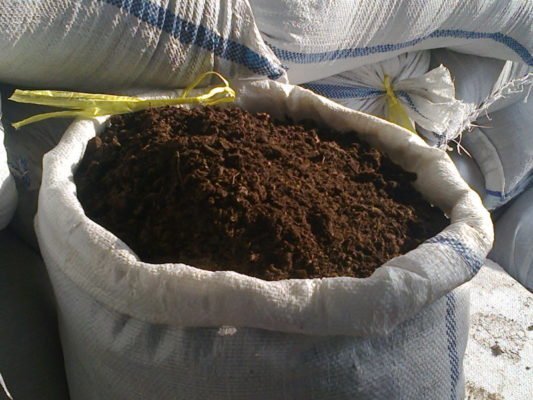
Humus is an effective remedy for increasing soil fertility
The wells are well spilled before planting the cabbage. It is imperative to adhere to the planting scheme (at least 60 cm between plants and 60–70 cm between rows) so that each head of cabbage has sufficient area for nutrition. The seedlings are transferred to a permanent place along with the pot. A little humus, a teaspoon of superphosphate and onion husks are placed at the bottom of the hole to repel pests. The cabbage is buried to the first pair of leaves, once again watered abundantly, mulched. Until it starts to grow, a canopy of white covering material is erected over the garden bed. Or each seedling is separately covered with spruce branches, paper caps.

Cabbage seedlings are planted in holes abundantly spilled with water, practically in the “mud”
In open ground, seeds of late cabbage are planted in late April or early May. The ground at a depth of 10 cm should warm up to at least 10–12 ° C. When planting, follow the scheme, put 3-4 seeds in each hole. Sprinkle them on top with peat chips or humus (a layer 2-3 cm thick).
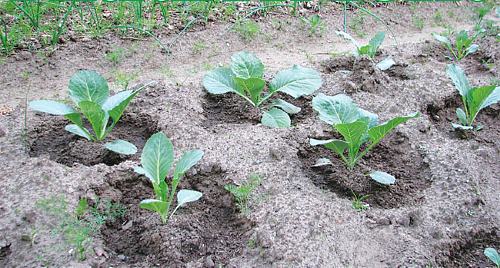
Cabbage (both seeds and seedlings) is planted in the ground, providing the plants with sufficient area to feed
Before the emergence of shoots, the bed is covered with plastic wrap. Then – tighten the covering material on the arcs. After a month, the shelter can be removed for a day, after another 1,5–2 weeks – removed completely. In the phase of the second true leaf, culling is carried out, leaving one seedling in each hole. “Unnecessary” cut with scissors or pinch at the very ground.
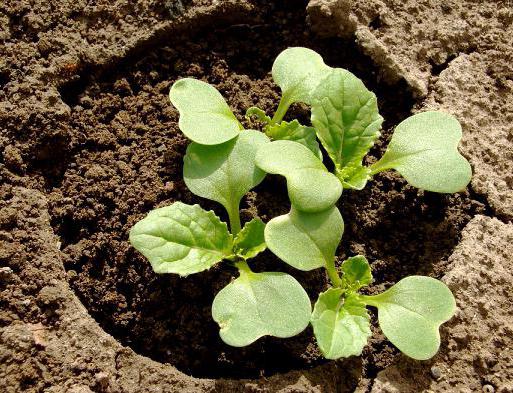
In open ground, seeds of late cabbage are planted only if the climate in the region allows
Water the seedlings in moderation. Plain water can be alternated with a pale pink potassium permanganate solution. To protect against fungal diseases, cabbage is powdered with crushed chalk or colloidal sulfur. Sprinkle the soil in the garden with a mixture of ash, tobacco chips and ground pepper. This will help ward off many pests.
Further Care
Late cabbage, like its other varieties, is regularly loosened, the garden is weeded. With loosening, you need to be very careful not to go deeper than 10 cm. About three weeks after planting, it is huddled to stimulate the development of more adventitious roots. The procedure is repeated after another 10-12 days and just before the leaves close into a continuous carpet. The shorter the stem, the more often you need to spud the plants.
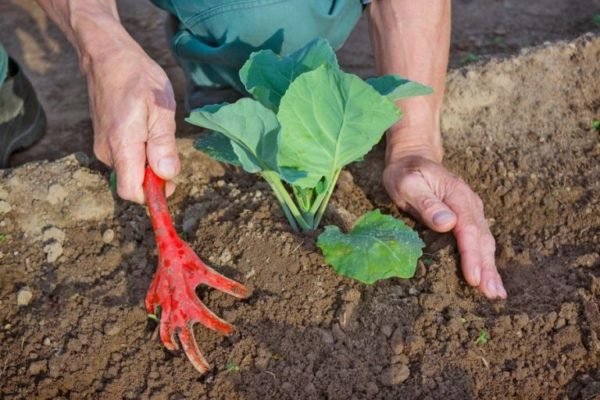
Ideally, the cabbage bed should be loosened after each watering – this promotes aeration of the roots, does not allow moisture to stagnate in the soil
The main component of cabbage care is proper watering. It especially needs moisture during August, during the formation of heads of cabbage. Freshly planted seedlings are watered every 2-3 days, consuming 7-8 liters of water per 1 m². After 2-3 weeks, the intervals between procedures are doubled, and the norm – up to 13-15 l / m². The soil must be soaked to a depth of at least 8 cm. Of course, the frequency of watering is highly dependent on the weather. In hot weather, cabbage is watered daily or even twice a day, early in the morning and late in the evening. You can also spray the leaves and cabbages additionally.
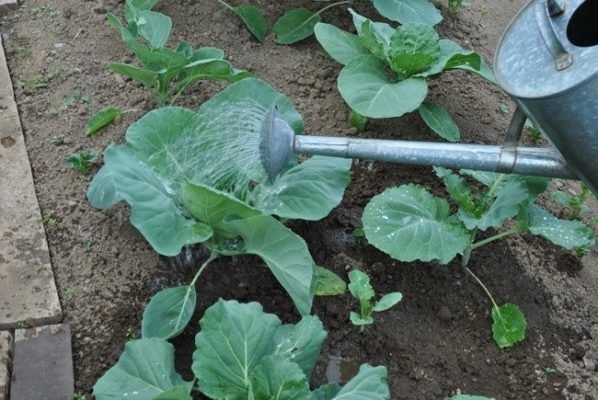
Cabbage is a moisture-loving culture, this applies to both newly planted seedlings and adult plants
It is undesirable to pour water directly under the roots. They are located in cabbage very close to the soil surface, quickly become bare and dry out. Better to water it using the grooves in the aisles. If technically feasible, sprinkler irrigation is organized (his cabbage is very fond of it) and drip irrigation. These methods allow you to evenly wet the soil.
It is categorically impossible to alternate long periods of drought with rare very abundant watering. This is the main cause of head cracking.
About a month before harvesting, watering is reduced to the required minimum. In this case, cabbage will become juicier, pick up the sugar content inherent in the variety.
The growing season for late cabbage is long, therefore, it requires more additional fertilizing per season than varieties of early and medium ripening. Begin to apply fertilizers simultaneously with the first hilling. Any nitrogen-containing products are suitable – ammonium sulfate, carbamide, ammonium nitrate. They are embedded in the ground at the rate of 10-15 g / m² or diluted in 10 liters of water. After a month, the procedure is repeated.
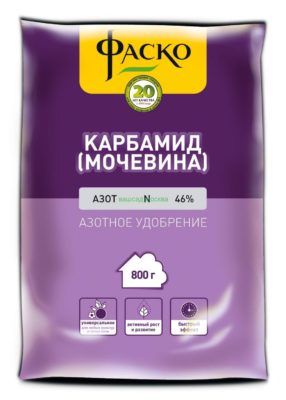
Urea, like other nitrogen-containing fertilizers, stimulates cabbage to actively build up green mass
Cabbage has a very positive attitude to any organic fertilizers. An excellent top dressing is an infusion of fresh cow dung, bird droppings, nettle greens, dandelion leaves. Cabbage is watered with it two to three times during the summer at intervals of a month. Before use, the infusion must be filtered and diluted with water in a ratio of 1:15 (if it is a litter) or 1:10 when using any other raw material. Complex fertilizers are no worse – Multiflor, Pure Leaf, Gaspadar, Agricola, Zdraven.
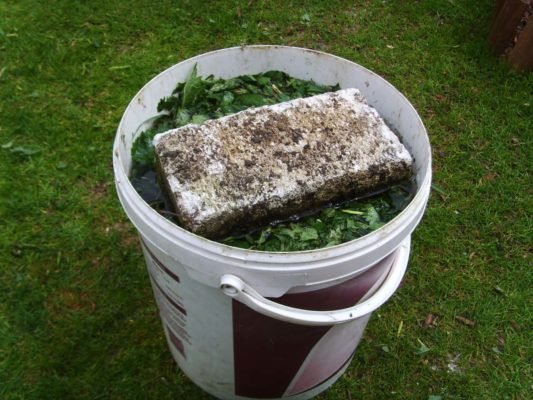
Nettle infusion is a very useful and absolutely natural fertilizer
Nitrogen is necessary for cabbage, but only in the first half of the growing season. In this case, it is worth strictly observing the recommended dosage. Its excess negatively affects the immunity of the plant, contributes to the accumulation of nitrates in the leaves.
As soon as the head of cabbage begins to form, they switch to potash and phosphorus fertilizers. Before harvesting, late cabbage is watered 1-2 times with a solution of superphosphate and potassium sulfate (25-30 g per 10 liters of water). Or you can add wood ash to the base of the stem every 1,5–2 weeks. An infusion is prepared from it (a half-liter jar for 3 liters of boiling water).

Wood ash is a natural source of potassium and phosphorus, especially necessary for late cabbage during the maturation of heads
Do not forget about foliar feeding. Cabbage especially reacts negatively to the deficiency of boron and molybdenum in the soil. During the season, it is sprayed 2-3 times with a solution of trace elements – 1-2 g of potassium permanganate, zinc sulfate, copper sulfate, boric acid, ammonium molybdenum per liter of water.
Video: caring for late cabbage after planting in the ground
The crop is harvested only after reaching full maturity. Unripe heads of cabbage are stored much worse. Most varieties and hybrids tolerate slight negative temperatures without damage to themselves, so it is better to wait with harvesting. Most often, late cabbage ripens in the first half of October, less often at the end of September.
Experienced gardeners 2-3 weeks before harvest are advised to chop the stem, cutting it by about a third, and slightly loosen the plant in the soil. The heads of cabbage will no longer be supplied with nutrients, grow in size and will definitely not crack.
Cabbage must be pulled out with roots. You can even store it directly like this by “transplanting” it into a box with wet peat or sand. But in this case, it takes up quite a lot of space.
Heads of cabbage intended for long-term storage are carefully examined, rejecting those on which even the slightest suspicious damage is noticeable. The stump is cut with a sharpened clean knife, leaving at least 4–5 cm. Two or three integumentary leaves do not need to be removed either. All sections are processed by sprinkling with activated carbon powder, colloidal sulfur, cinnamon.
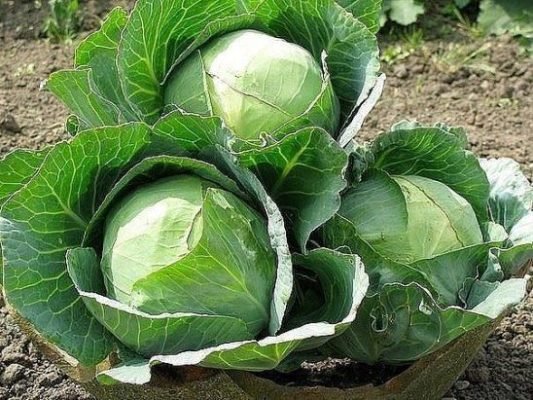
Cabbage for long-term storage is carefully selected
Before laying the cabbage for storage, the cellar or basement must be disinfected by wiping all surfaces with a solution of slaked lime. Heads of cabbage in one layer are laid out on shelves covered with shavings, sawdust, straw, sand, and scraps of newsprint so that they do not come into contact with each other. To prevent the development of fungal diseases, it is recommended to dust them with crushed chalk or wood ash.
To save space, the heads of cabbage are tied in pairs by stumps and hung on a wire or rope stretched from the ceiling. In this case, it is also desirable that they do not touch each other.
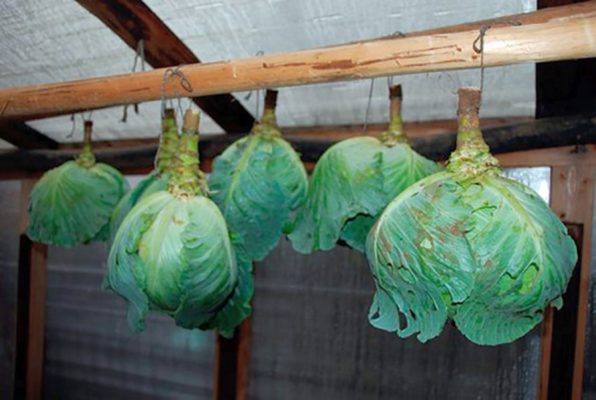
This unusual way of storing cabbage saves space in the cellar.
Even the best varieties and hybrids of late cabbage will not last long if you do not provide them with suitable conditions. Cabbage is stored in a dark place with good ventilation at a temperature of 2–4 ° C and an air humidity of 65–75%.
Video: cabbage harvest and storage
Reviews of gardeners
You have to wait a long time for the harvest of late cabbage, but this is more than compensated by the keeping of the heads of cabbage. Crop care has its own nuances, which you need to know about in advance, but there is nothing difficult in growing late-ripening varieties and hybrids. Often the most difficult choice for the gardener is the choice. After all, the area of the site is limited, and there are a lot of varieties of culture. And each has its own indisputable merits.
